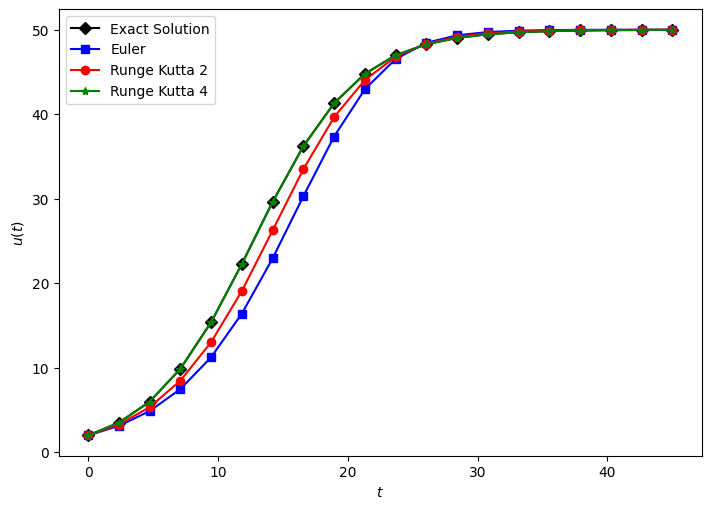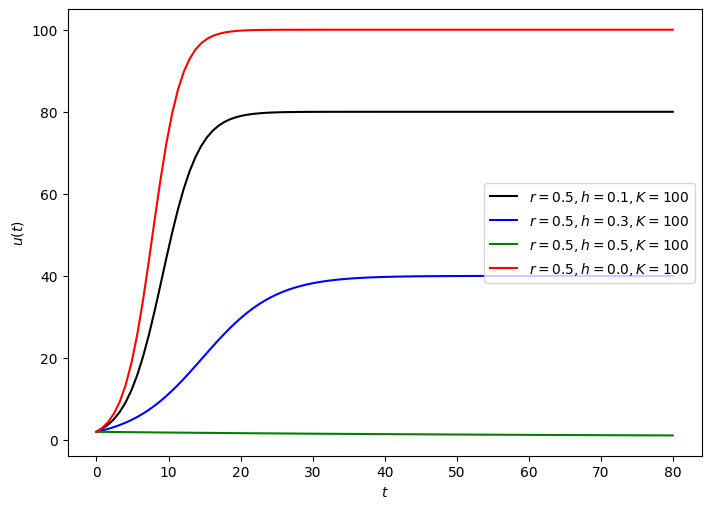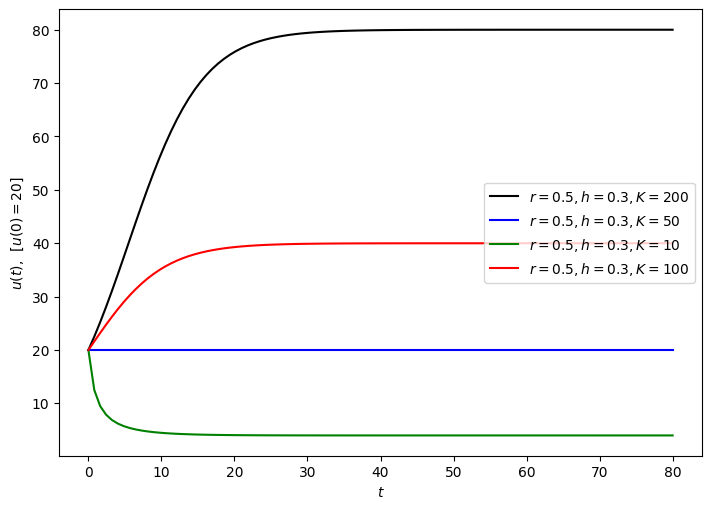import numpy as np
import matplotlib.pyplot as plt
Modelling population size#
Let \(u\) be a function modeling a mobile population living in an environment with a growth rate of \(r\)% per year with a carrying capacity of \(K\). The typical equation that governs the size of the population is,
Now assume that hunters harvest \(h\)% of the population per year. This can be accounted for in the above equation by adding an additional hunting term.
The second equation is a first-order nonlinear ordinary differential equation. The parameter space for \(u\) can defined from \(u\in [0, \infty)\), where the carrying capacity, \(K \in \mathbb{R}^+\). We will see that after solving the differential equation the \(u\) actually only goes from \(0\) to \(K\). Both \(r, u \in [0,1]\), as they represent the fraction of population growing/getting hunted. Since this is an initial value problem, we need to provide some population size at time \(t=0\). Assuming we need at least 2 organisms to reproduce, we provide \(u(0)=2\). However the solution will not be much different with any other small value of \(u(0)\).
Setting up the simulation#
Euler’s explicit method
def euler(f,u0,t, dt, r, h, K):
u = np.zeros(len(t))
u[0] = u0
for i in range(0,len(t)-1):
u[i+1] = u[i] + f(u[i],t[i], r, h, K)*dt
return u
Runge Kutta 2 Method
def rk2(f,u0,t, dt, r, h, K):
u = np.zeros(len(t))
u[0] = u0
for i in range(0,len(t)-1):
K1 = dt*f(u[i],t[i], r, h, K)
K2 = dt*f((u[i]+K1/2),(t[i]+dt/2), r, h, K)
u[i+1] = u[i] + 1/2*(K1 + K2)
return u
Runge Kutta 4 Method
def rk4(f,u0,t, dt, r, h, K):
u = np.zeros(len(t))
u[0] = u0
for i in range(0,len(t)-1):
K1 = dt*f(u[i],t[i], r, h, K)
K2 = dt*f((u[i]+K1/2),(t[i]+dt/2), r, h, K)
K3 = dt*f((u[i]+K2/2),(t[i]+dt/2), r, h, K)
K4 = dt*f((u[i]+K3),(t[i]+dt), r, h, K)
u[i+1] = u[i] + 1/6*(K1 + 2*K2 + 2*K3 + K4)
return u
Define \(\frac{du}{dt}\)#
def dudt(u, t, r, h, K):
return r*u*(1-(u/K)) - (h*u)
Comparing different methods#
# Initial Conditions
u0 = 2
r = 0.5
K = 100
h = 0.25
# setting up the time array
t0 = 0
tf = 45
points = 20
t = np.linspace(t0, tf, points)
dt = t[2]-t[1]
u_Euler = euler(dudt,u0, t, dt, r, h, K)
u_RK4 = rk4(dudt,u0,t, dt, r, h, K)
u_RK2 = rk2(dudt,u0,t, dt, r, h, K)
u_exact = (50*np.exp(0.25*t))/(24.+np.exp(0.25*t))
# plotting
plt.figure(num=1, figsize=(7, 5))
plt.plot(t,u_exact,'Dk-', label = "Exact Solution")
plt.plot(t,u_Euler,'sb-', label = "Euler")
plt.plot(t,u_RK2,'or-', label = "Runge Kutta 2")
plt.plot(t,u_RK4,'*g-', label = "Runge Kutta 4")
plt.legend()
# plt.grid(True, color='lightgray')
plt.tight_layout()
plt.xlabel("$t$")
plt.ylabel("$u(t)$")
plt.savefig('plots/5a/comparison.png', dpi=200)

Solutions#
Variation of hunting rate, \(h\)#
plt.figure(figsize=(7, 5))
t0 = 0
tf = 80
points = 100
t = np.linspace(t0, tf, points)
dt = t[2]-t[1]
u0=2
plt.plot(t, rk4(dudt,u0,t, dt, r=0.5, h=0.1, K=100),
'k-', label = "$r=0.5, h=0.1, K=100$")
plt.plot(t, rk4(dudt,u0,t, dt, r=0.5, h=0.3, K=100),
'b-', label = "$r=0.5, h=0.3, K=100$")
plt.plot(t, rk4(dudt,u0,t, dt, r=0.5, h=0.5, K=100),
'g-', label = "$r=0.5, h=0.5, K=100$")
plt.plot(t, rk4(dudt,u0,t, dt, r=0.5, h=0.0, K=100),
'r-', label = "$r=0.5, h=0.0, K=100$")
# plotting
plt.legend(loc='right')
plt.tight_layout()
plt.xlabel("$t$")
plt.ylabel("$u(t)$")
plt.savefig('plots/5a/varyH.png', dpi=200)

Variation of growth rate, \(r\)#
plt.figure(figsize=(7, 5))
t0 = 0
tf = 80
points = 100
t = np.linspace(t0, tf, points)
dt = t[2]-t[1]
u0=2
plt.plot(t, rk4(dudt,u0,t, dt, r=0.6, h=0.3, K=100),
'k-', label = "$r=0.6, h=0.3, K=100$")
plt.plot(t, rk4(dudt,u0,t, dt, r=0.3, h=0.3, K=100),
'b-', label = "$r=0.3, h=0.3, K=100$")
plt.plot(t, rk4(dudt,u0,t, dt, r=0.1, h=0.3, K=100),
'g-', label = "$r=0.1, h=0.3, K=100$")
plt.plot(t, rk4(dudt,u0,t, dt, r=0.4, h=0.3, K=100),
'orange', label = "$r=0.4, h=0.3, K=100$")
plt.plot(t, rk4(dudt,u0,t, dt, r=1.0, h=0.3, K=100),
'r-', label = "$r=1.0, h=0.3, K=100$")
# plotting
plt.legend(loc='right')
plt.tight_layout()
plt.xlabel("$t$")
plt.ylabel("$u(t)$")
plt.savefig('plots/5a/varyR.png', dpi=200)

Variation of carrying capacity, \(K\)#
plt.figure(figsize=(7, 5))
t0 = 0
tf = 80
points = 100
t = np.linspace(t0, tf, points)
dt = t[2]-t[1]
u0=20
plt.plot(t, rk4(dudt,u0,t, dt, r=0.5, h=0.3, K=200),
'k-', label = "$r=0.5, h=0.3, K=200$")
plt.plot(t, rk4(dudt,u0,t, dt, r=0.5, h=0.3, K=50),
'b-', label = "$r=0.5, h=0.3, K=50$")
plt.plot(t, rk4(dudt,u0,t, dt, r=0.5, h=0.3, K=10),
'g-', label = "$r=0.5, h=0.3, K=10$")
plt.plot(t, rk4(dudt,u0,t, dt, r=0.5, h=0.3, K=100),
'r-', label = "$r=0.5, h=0.3, K=100$")
# plotting
plt.legend(loc='right')
plt.tight_layout()
plt.xlabel("$t$")
plt.ylabel("$u(t),\,\,\,[u(0)=20]$")
plt.savefig('plots/5a/varyK.png', dpi=200)

